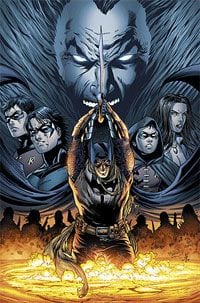
As a giant fanboy and self-professed nerd, I have come to accept the fact that in comic books, the more things change the more they really do stay the same. Heroes and villains die only to be reborn later, massive alterations are later reconciled with the previously established mythos, and all the while “suspension of disbelief” covers what is really an unbroken line of continuity with only the illusion of change and progression. Massive upheavals, despite our belief that this time things will be different, ultimately return to a normalcy. Even Jason Todd and Bucky, two characters we used to be certain would never return, have been brought back. I am not complaining about this; it is a necessary byproduct of the narrative structure of the superhero genre. However, I think all fanboys can agree that there is a proper way to handle these situations, and an improper way. Sadly, despite the loads of talented creators that were involved, The Resurrection of Ra’s Al Ghul falls into the latter category. The story is often confusing, the transition from one title to another is clumsy and awkward, and the actual return of one of Batman’s greatest foes is not handled with the care it deserves.
The Resurrection of Ra’s Al Ghul is a seven part series that includes a prelude and an additional origin story. It takes place across DC’s Batman-oriented titles: Batman, Detective Comics, Robin and Nightwing. Grant Morrison, Paul Dini, Peter Milligan, and Fabian Niceiza — all quality writers — make up the creative pool that, along with the solid art team, tells the story. The basic premise is that Ra’s Al Ghul (who died in the fantastic mini-series Batman: Death and the Maidens by Greg Rucka) has a new method to extend his life and return from the grave yet again. In this case Ra’s plans to use the body of his grandson Damien — the child of Batman and Talia Al Ghul who was reintroduced into Batman continuity after Infinite Crisis — to be the host for his spirit. Damien learns of the plan and flees to his father, bringing a trail of ninja assassins and arrogant teenage angst with him. Although Batman is able to save his son in the end, Ra’s does return from the grave with the assistance of another host body provided by his son the Grey Ghost.
Despite the top talent involved in this storyline the book is boring, confusing, and not well put together. While normally I tend to accentuate the positive elements in my reviews — I feel that what I liked is probably of greater use to the readers then what I disliked — there is very little to be applauded in this series. For starters the transition from book to book is not the seamless narration that we have come to expect from DC. During this period of epic events and massive crossovers throughout the DCU, they have provided fans with multiple examples of quality editing and expertly developed series’ involving multiple creators. In The Resurrection of Ra’s Al Ghul however, none of this is shown. One can’t help but get the feeling that after the series was completed the writers all looked at one another and said, “I thought you were supposed to write that part of the story.”
Another problem with this book is the plot holes and the addition of random characters in the mythology. Either I’m not as big a Batman fan as I thought, or there were far too many new characters added to the story. Ra’s Al Ghul’s son and father, both motivated by uninteresting one-dimensional stimuli, are driving plot devices that seem more like mechanisms to fill pages and introduce fight sequences then anything else. While the origin story provided in Batman Annual #26 is helpful, what this series really needs is a Secret Files and Origins; a successful tool used to by DC before when they have needed to provide background and context. Moreover, the method that Ra’s Al Ghul uses to bring himself back flies in the face of his entire previous storyline. He survives by Lazarus Pits but suddenly one of his minions discovers some new way of cheating death. Death isn’t much of an issue in comics but this type of formulaic convenience verges on the ridiculous. The last plot issue is that in Death and the Maidens, Ra’s Al Ghul chooses death by his daughter, Nyssa, naming her his heir. This series makes no mention of that decision and thus raises the important question: why would a person who previously chose death, now fight so hard to come back to life?
Ultimately this series is representative of the potential hazards that can arise when one works in the comic book medium. From a continuity perspective the story is weak, the new characters lacking substance, and the plot ignores what has preceded it. Technically, the book is not well edited and suffers from an inconsistent narrative agenda. Batman fans will dislike the awkward additions and changes, and new readers will find the book inaccessible and confusing. While fanboys and geeks have learned that bringing characters back from the dead is the rule rather then the exception, we have at least come to expect a certain degree of elegance and care. Sadly, this series exhibits neither.

![Call for Papers: All Things Reconsidered [MUSIC] May-August 2024](https://www.popmatters.com/wp-content/uploads/2024/04/all-things-reconsidered-call-music-may-2024-720x380.jpg)



